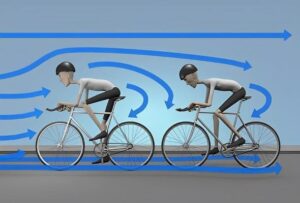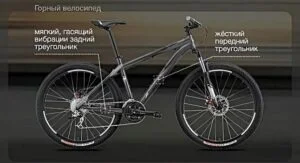In the article “Cycling” we will tell you about the sport that is based on cycling. You will get acquainted with its history, with types and features of equipment.
#Cycling #Bicycling #Pedaling #Bicycle #Sports
The term “cycling” is used in the modern world to refer to bicycle racing. Today there are various competitions: Road, Track, BMX and Mountain racing.
Cycling is one of the most popular sports in the world and was included in the Olympics in 1896. The Tour de France is the leading cycling event, attracting 12-15 million spectators each year and is the largest sporting event.
At the moment it is impossible to say exactly who was the inventor of the first bicycle, but there are several versions. The first version attributes the invention to Leonardo da Vinci, as there is a drawing sketch dating back to 1493.
According to the second version, the inventor is the Russian blacksmith Artamonov. At the beginning of the 19th century he created a kind of vehicle that resembled a modern bicycle. It was said that he even rode it 5,000 kilometers from Yekaterinburg to Moscow to show the tsar his invention.

The German Baron Carl von Drez is considered the official inventor of the bicycle. In 1817, he patented his invention, the “jogging machine. The first bicycle had no pedals, it was more like a scooter, and it was possible to move by pushing off the ground.
The first official bicycle race was held in 1868 in Paris. The distance of this bicycle race was only 1.2 kilometers, which is a sprint in today’s times. Cycling quickly became popular around the world.
The Olympic program in 1896 included one road race and five track events. In 1996, mountain bike races were added to the events, and in 2008, BMX races were added. Today there are 11 women’s and men’s events at the Olympics.
Vyacheslav Ekimov and Olga Slyusareva are the most famous cyclists among our athletes. Vyacheslav was three-time Olympic champion (1988, 2000, 2004) and six-time world champion. Olga was able to win the gold medal at the Olympics in 2004, and she is also 6-times World Champion in Track Cycling.
The rules of cycling are self-explanatory. Whoever crosses the finish line first wins. At the same time, you can not knock down opponents and interfere with their bikes. There are also very original rules, which describe that you have to move on your bike by yourself, as athletes have managed to move by holding on to the car.

Throughout the race, the rules are monitored by special volunteers, also called commissioners. Their task is to follow the safety rules, and to prevent violations along the entire route. The commissioners are also involved in preparing the course and coordinating the races with the local police.
In cycling, there are both individual and team competitions. Team competitions often use a strategy that involves taking the leader to the lead. For example, a team of 8 riders surrounds the leader, cutting through the air. The airflow makes it 20-40% easier for the leader to move and thus saves him energy for the final push.
Types of races in cycling
- Road races take place on roads and streets. The most famous competition is the Tour de France. Many road races are held in a “multi-day” format, when the race is held in several stages over several days.
- Off-road Racing. This type includes mountain bike, motocross, cross-country, and BMX races. Competitions take place on uneven terrain, including grass, gravel, dirt, soil and even rocks.
- Track racing takes place on a velodrome. The track is a circle in a stadium made of wooden panels with steep slopes.

Cycling is not a cheap sport, as the cost of the bike alone can be as much as $1 million. All professional bicycles are made of carbon fiber.
What is good about this material? It is stronger than metal and stiffer than aluminum, while being several times lighter. A lighter bike gives the rider at least a 10-15 second advantage per race, and that’s huge for modern sports.
The speed of a bicycle is directly related to its weight. A bike part weighing as little as 100 grams equals an extra kilogram to the rider’s total weight. That’s why athletes not only diet, but also try to make the bike as light as possible by getting rid of even the extra bolts.
As much as riders would like to make their bikes weightless, the International Cycling Union has imposed strict limits. A road bike must weigh at least 6 kg and 800 grams.

In addition to weight restrictions, the international federation also controls the aerodynamic properties of the bicycle. It has imposed a ban on the development of bicycles with aerodynamic fairings, which cost hundreds of thousands of euros, in order to level the playing field in the world championships and the Olympic Games.
Interesting fact, only due to the most basic aerodynamic components: professional equipment, bicycle helmet and carbon frame, the rider saves 60 to 70 watts of own power at an average speed of 40 km / h. This means that the cyclist gains 9 seconds per kilometer.
All professional cycling equipment is made of high-tech materials, polyester and polyamide. These synthetic fabrics have unique properties, they are lightweight, perfectly breathable and regulate heat exchange well. A uniform made of these materials provides the rider with good aerodynamics and maximum comfort.
Since the cycling uniform is worn on the naked body, the manufacturers are trying to get rid of seams as much as possible, to eliminate friction and turn the clothes, in fact, into a second skin of the rider. The latest technological achievement in this area is seamless production.

The most important and the most delicate part of the biking suit is the diaper. A professional cyclist spends about five hours a day on a hard saddle, a diaper is the only thing that can soften the friction of the skin against the saddle.
A cycling diaper consists of three layers. The first layer is made of super-soft fabrics, it contacts the skin tightly. The second layer is shock-absorbing, it smoothes the impact of the saddle on the body on bumps and potholes. The third layer is the stabilizing layer, it fixes all the other parts and is sewn to the cycling suit.
Coaches say that the most favorable age for cycling is 4-5 years, because at this age is formed body. Most sections as their ranks are accepted from 8 years, and the future cyclist should have the basic concepts and skills of cycling.
Cycling strengthens the cardiovascular system, improves endurance, posture and coordination, strengthens bones, and reduces depression. Exercising on a bicycle helps prevent many serious diseases, such as brain problems, diabetes, and cancer. Get on a bike, and be healthy!
About cycling
FAQs
What is cycling?
Cycling is a cyclic sport in which an athlete covers a certain distance on a bicycle. There are three types of racing in cycling: road racing, off-road racing, and track racing. Each discipline uses a different type of bicycle.
Why in cycling is the back wheel covered?
All bicycles are rear-wheel drive. The rear wheel carries the heaviest load as it propels the bicycle and supports the weight of the rider. A disc wheel is installed in order to reduce the occurring friction force of the rear wheel, to give it additional stiffness (reduces the reaction time to the actions of the cyclist), to improve aerodynamic performance. In addition, the rear wheel is less sensitive to side wind.
Why are long socks prohibited in cycling?
It is believed that by using long socks, the cyclist gains an aerodynamic advantage that is measured in time. Studies show that the savings are substantial, amounting to up to 16 seconds per 40 km of track. The research is logical, since wetsuits in swimming have also revolutionized it.









